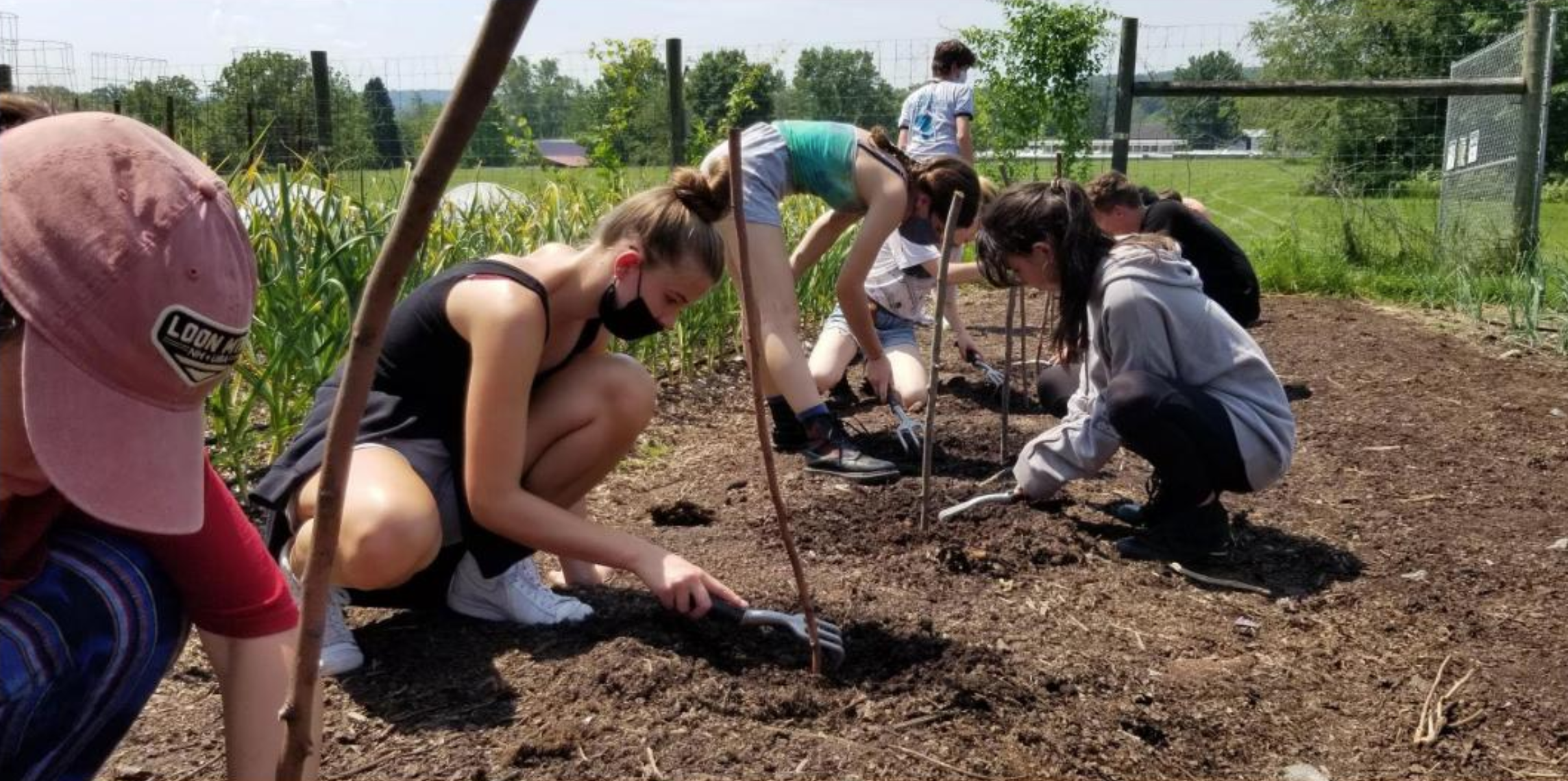Sponsored Content
Celia Martin, the gardening teacher at Kimberton Waldorf School, stands in the middle of the two-acre garden that she and her students care for. Two high school students pull weeds while talking. Martin looks at her watch. “They don’t know it’s 11 already.” It’s another blazing hot July day, but despite the heat, they chat happily, so Martin reminds them that their shift is over.

Located in Phoenixville, Kimberton Waldorf sits on a whopping 450 acres, about 420 of which are leased to the dairy farm Seven Stars Farm. Every spring, all students—the school offers early childhood care and extends through 12th grade—witness the cows as they are released to graze in the grass for the first time for the season. The cows are so happy, Martin says, that they joyfully kick up their heels.
On the grounds in the garden is a structure made from woven willow wattle branches which houses some gardening tools. Third graders weaved the fibers; structure building is part of the curriculum they learn at that age. There’s also a greenhouse that was built by a student fifteen years ago.
“Being outside in the garden opens kids up to this experience of discovery and wonder.”
— Celia Martin, gardening teacher at Kimberton Waldorf School
Martin has been tending the garden since 2008. It’s a diverse and highly productive garden, one that supplies the school’s kitchen with tomatoes, potatoes, peppers, cucumbers, squash, onions, garlic and many different herbs.
Martin points across a long, hilly expanse of grass toward the classroom buildings. She says that, no matter the weather, students walk from their classrooms across the grass to the garden to work and learn.
“You come with your boots and your raincoat, and your jacket and your layers. All students have an extra change of clothes, even in high school. It’s not just for early childhood,” Martin says.
Martin studied agriculture in college, but she says the focus of the curriculum was to teach people how to farm profitably. Her goal for her students is much different: to get kids to understand that their food comes from plants that need to be tended. But her ambitions extend beyond that.
“These are the kids who will face the climate crisis that’s looming. These are the generations that are really going to have to work to do something about it. If they’re not exposed to nature, then they don’t know it. And if they don’t know it, how are they going to care about making a change?”
Martin talks about the seminal book “Last Child in the Woods” by Richard Louv, who coined the phrase “nature deficit disorder.” She stresses the importance of engaging all five senses, not just the ones you need to interact with a screen.
“Being outside in the garden opens kids up to this experience of discovery and wonder. When you’re sitting in front of a computer, there’s not a whole lot of sensory input. It’s basically your vision, you’re not even aware of what you’re touching. But when you come out here, it brings your senses alive.”
Woven throughout this textured approach to education are the three pillars of Waldorf education: rhythm, repetition and reverence. Schedules are structured so the days “breathe,” which means a difficult math class might be followed by a nature hike. Again, the gardening component provides the perfect backdrop for these values.
“Fifth graders will have gardening in the spring,” says Martin, “and they will start the seeds and plant them in the garden. When they come back as sixth graders in the fall, they are harvesting the exact plants that they planted. They will go through multiple cycles with the garden, hopefully learning things a little more deeply with each repetition.”
Ona Wetherall has been teaching early childhood classes at Kimberton Waldorf since 2014, and recently served as the Interim Dean. Wetherall sees how critical rhythm is for the entire student body.
“Rhythm helps us to learn how to self-regulate, and that’s important at any age. Rhythm is something that we can rely on and ground ourselves in.”
Of course, within the stability of rhythm, there is a recognition that the world is constantly in flux. “Our education is a holistic education,” says Wetherall. “It’s really connected to what’s happening in the world around us. Our circle games, and our stories and our activities—they all are in line with what’s going on in nature.”
One of the tasks that middle schoolers undertake is outdoor journaling. “It’s actually deepening their understanding of the rhythms of the season, so it’s giving them a chance to be self-reflective, but also reflective of the world around them.”
Wetherall, as an early learning teacher, has a unique vantage point in the students’ educational experience.
“It’s really special for me, I get this privilege of seeing the students start their educational journey with me, and then I see them working their way up through the grades, which is really an amazing thing to witness. The educational journey is really intentional. And so even when the kids are with me, and they’re two and three years old, I know, as a faculty member of the Kimberton Waldorf School, the intentional journey that I’m setting them up for. There’s a continuity that builds on itself.”
And cultivation, whether it’s plants or children, takes time, which brings us back to the garden. Martin says, “Everything in our society today is immediate. You want something, Amazon delivers it the next day. In a garden, nothing is immediate. So, the third grade planted the pepper seeds, way back in the beginning of March, 60 days later, they were planting those plants out in the garden. You just have to wait and be patient, and finally, you get your reward.”
The mission of Kimberton Waldorf School is to teach students to be creative and critical thinkers with a strong moral compass. With a developmentally appropriate, experiential and artistic approach to education, we enable the unfolding of each child’s unique capacities to meet the world with confidence and a sense of purpose.










